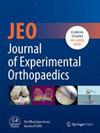Side-to-side characterisation of cellular content, soluble factors and in vitro potential on chondrocytes for bone marrow aspirate concentrate and adipose-derived stromal vascular fraction
Abstract
Purpose
Orthobiologics gained popularity for the treatment of musculoskeletal pathologies, including osteoarthritis (OA). Bone marrow aspirate concentrate (BMAC) and adipose-derived stromal vascular fraction (SVF) were reported to reduce OA symptoms, contributing to the restoration of joint homoeostasis. Variability in production protocols and lack of extensive characterisation hinder a clear indication for the choice of a product over the other. The purpose of this study was to characterise side-by-side BMAC and SVF obtained with the same family of devices, by assessing cell immunophenotype, release of soluble factors and their ability to reduce inflammation in a pathologic in vitro chondrocyte model.
Methods
BMAC (iliac crest) and SVF (abdomen liposuction) were obtained from 28 (55 years old ± 8) and 39 patients (56 years old ± 9), with Hy-Tissue BMAC and Hy-Tissue SVF. BMAC/SVF were characterised for cellular content. The number of mesenchymal stromal cells (MSCs) was investigated by flow cytometry (CD45−CD31−CD34+CD90+CD105−/LCD146−, adipose-MSCs; CD45−CD271+, bone marrow-MSCs). Two-hundred factors (cytokines, chemokines, receptors, growth factors and inflammatory molecules) were tested by enzyme-linked immunosorbent assay (ELISA). Anti-inflammatory potential was assayed in vitro on interleukin-1 beta (IL1β)-treated chondrocytes by quantitative reverse transcription polymerase chain reaction (qRT-PCR) arrays of 84 genes involved in inflammatory processes.
Results
BMAC had higher concentration for white cells (213x), erythrocytes (49x) and platelets (25x), while the number of MSCs resulted comparable between the two products (1000 cells/mL). One-hundred and twenty-one soluble factors were identified in all analysed samples, with 88 more abundant in BMAC and one in SVF. Gene ontology revealed that the higher concentrated molecules were mainly growth factors and/or involved in differentiation processes. Both orthobiologics reduced inflammation in the in vitro chondrocyte model, with BMAC showing higher efficacy.
Conclusions
Using specific commercial systems, both orthobiologics showed anti-inflammatory effects in vitro. BMAC had higher blood cell and growth factor concentrations than SVF, with greater efficacy. However, variability in commercial systems limits generalisation, requiring further study to draw conclusions when different devices are employed.
Level of Evidence
NA


 求助内容:
求助内容: 应助结果提醒方式:
应助结果提醒方式:


